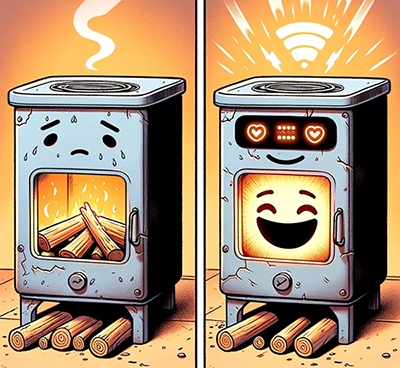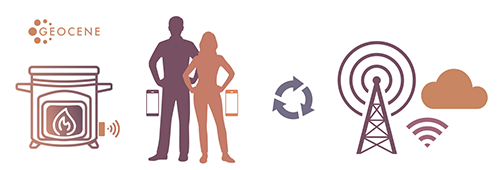The Summary: Engineering an Improved Cookstove Market
Summary
Cookstove carbon finance is retracting because projects do not provide good evidence of offsets. Stove Use Monitors (SUMs) can win back carbon finance money while increasing the impact and profitability of projects. Geocene makes the world’s best SUMs, and they more than pay themselves back in additional carbon finance revenue. Read more here.
Details
Cookstove carbon finance is in an over-crediting kerfuffle. A controversial paper by Annelise Gill-Wiehl about pervasive over-crediting is causing a major retraction in the carbon market. My friends in the sector say most stove companies are laying off staff, and several estimated that $100M or more in offset contracts evaporated in the last year.
Shoddy methodologies that don’t employ monitoring led to a lack of trust among buyers. But there’s a way to earn trust back, achieve bigger impacts, and earn more carbon revenue all at the same time: data, lots of good-quality, objective sensor data.

After many, many, (many) attempts, this was DALL·E 3’s best shot at “sad cookstove without sensor vs. happy cookstove with sensor.”
Of the eight key contributors to over-crediting, five can be addressed using stove use monitors (SUMs): stove adoption, stove usage, fuel consumption, stacking, and rebound. For years, I heard that SUMs are just too expensive and cumbersome. But times have changed: today SUMs are affordable and simple to use, and the reality is that future carbon finance projects will mandate large-scale monitoring.
Paradoxically, even though monitoring costs money, total project profitability can still increase. I’ll prove it to you. The key to understanding how paying for monitoring can lead to more profits is to focus on the price of the credits themselves. We can generalize the profitability of a carbon finance program as:
profit = price_per_ton * abatement - costs
Of course sensors add to costs. And, sadly, for almost all projects, objective monitoring will find that the adoption (and thus abatement) is lower than the project hoped for. So how can the added cost of sensors that prove lower adoption possibly be good for the bottom line?
The key is that SUMs also dramatically increased the prices that carbon offsets command. Geocene talks to a lot of carbon-financed cookstove programs, and we regularly hear stories of high-quality monitoring driving prices from $5-$10/ton to $10-$20/ton. We even know of one project with exemplary monitoring that is commanding $40/ton. This is because higher-quality evidence-based credits can be sold for a much higher rate. The comparison in the table below shows a more expensive SUMs-based project with lower proven adoption earning higher net revenue.

Two carbon finance programs. The more expensive program with SUMs earns higher profits even though it finds lower adoption.
Carbon financing isn’t just about financial figures. It’s about what those extra earnings enable. If we can earn higher revenues from successful cookstove projects, the sector will use those earnings to create even better improved stoves. Better stoves will be better loved, adoption will increase, and SUMs will verify that adoption. This virtuous cycle could drive carbon prices and revenues even higher.

Geocene’s mission is to enable this future. We want a world where everyone has access to clean and affordable cookstoves. To create that world, we have spent the last 14 years building the world’s best SUMs. We have manufactured more SUMs, collected more data, and monitored more stoves than any other company—10k SUMs, 25 countries, and 2.5 million stove-days measured. We believe in SUMs, and we’re committed to making a future of ubiquitous monitoring happen.
That is why we are launching the SimpleSUM. The goal of SimpleSUM is to make monitoring ubiquitous for carbon finance projects by making SUMs affordable and available to every cookstove project in the world.

SimpleSUMs collect and store encrypted data. When someone with the Geocene mobile app comes near, the data transfers to their phone over Bluetooth. Later, when cellular or Wi-Fi is available, the data goes to the cloud.
SimpleSUMs use a super-rugged thermocouple probe to measure cookstove use. Data is stored onboard until someone running the Geocene app walks nearby. Then, the encrypted data hops to the phone over Bluetooth. The phone syncs the data to the cloud when there is cellular or Wi-Fi available. In the cloud, all of your data is processed, organized, summarized, and built into easy-to-understand reports for investors and project managers. The SimpleSUM is just… simple.
All of this, and it is affordable too. For most projects, total cost of monitoring across the fleet equates to just about $2 per stove per year. We even offer the opportunity to lease the SUMs with zero up-front cost.
If you’re interested and want to learn more about the technology, pricing, or just chat on the phone, you can check out carbon.geocene.com, or email me at danny@geocene.com, or put some time on my calendar, or call me at +1 707-297-3465.
It’s time to end the senseless emissions, disease, and drudgery of traditional cooking. Let’s do it together with SUMs.

The SimpleSUM simply works. It’s affordable, rugged, and proven to work in most challenging environments.
